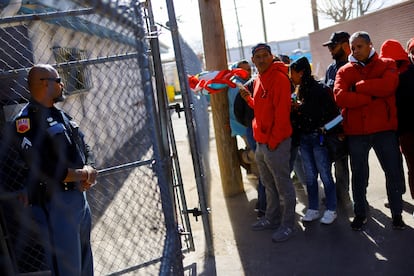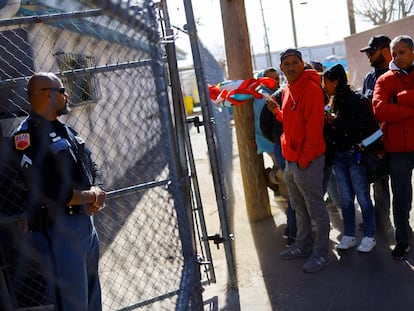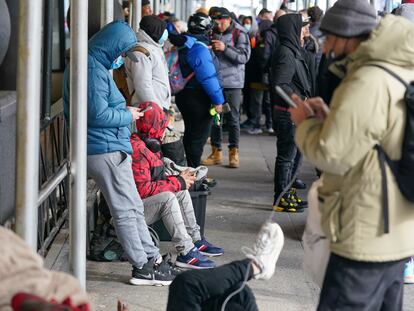New York’s homeless shelters house more than 100,000, mostly migrants
Since the spring of 2022, more than 81,000 immigrants, many of them Venezuelans, have arrived in the city from the southern border


One out of every 80 inhabitants of the largest city in the United States, New York, with a population of over eight million, has no place to live. If one adds to the native homeless the thousands of migrants arriving in the Big Apple from Texas or Arizona, sent since the spring of 2022 by the Republican governors to put pressure on the Democratic Administration -both the city and the federal one-, the volume of occupancy that the network of municipal shelters has reached this week is not surprising. More than 100,000 people, more than half of them migrants, are currently staying in the hundreds of shelters, hotels or camps (“emergency relief centers”, in the official terminology) set up by the city for this purpose; this is the first time that the number has reached six digits. The influx has multiplied the costs, as the mayor, Democrat Eric Adams, tirelessly repeats, trying to obtain from the State and Washington additional economic aid to face the phenomenon. The city has spent more than $1 billion in the last year, and expects to spend more than $4 billion next year.
The demographic make-up of the two groups of people housed varies: compared to families with children, who account for two-thirds of the migrants, the indigenous homeless offer individual and, in many cases, problematic profiles, due to a combination of addictions and untreated mental disorders. But pressure from the former is testing New York’s status as a traditional immigrant haven. In fact, in recent months, the mayor has cut back on provisions that legally protected shelter, as a result of the massive influx, which has led many to other parts of the State, not always predisposed to welcome them.
Two communities that theoretically do not intermingle, the local homeless and the migrants, many of them asylum seekers or temporary refugees, coexist in facilities at the limit of their capacity. Adams has tried everything: gigantic tents in parks or at the port; the collaboration of religious groups and, now, the distribution of migrants throughout the state (two months ago, it was the transfer of migrants to the Canadian border, in specially chartered buses). Just this week the mayor announced the opening of the city’s twelfth Humanitarian Emergency Relief and Response Center, which will serve 500 family units. In total, there are 175 emergency shelters, which not only offer beds, but also the necessary support network to process papers, provide job counseling and offer immediate schooling in the public school network to minors.
In the week of June 19-25 alone, 2,500 asylum seekers were admitted to the shelters. Overshadowed by the influx of migrants, the other occupants of the places are non-immigrant homeless, showing that the native-born population has also grown. When Adams took office on Jan. 1, 2022, there were 45,000 people in the main shelter system, locals and outsiders combined. Since the Republican governors of Texas and Arizona began chartering buses to New York to clear the border, the number has doubled, and a total of 81,200 people, mostly Venezuelans, have arrived in the city. At least 17,000 migrants are living in facilities outside the municipal shelter system, such as large hotels and other specially designated places.
In May, after the expiration of Title 42, a pandemic-inspired rule that allowed authorities to automatically turn back foreigners after crossing the border, the influx of migrants into the Big Apple accelerated, prompting the city to seek a judicial waiver of its unique, legally enshrined “safe harbor” mandate to offer a bed to anyone who wanted one. Especially since there was no more room, hence the daily queues in front of churches and NGOs. Last October, Adams declared a state of emergency in the city while asking Washington to speed up the granting of Temporary Protected Status (TPS), which allows migrants to live and work without fear of deportation, while their asylum request is being processed.
The emergency of the migratory crisis often prevents from seeing the urgency of helping the local homeless, who are often presented as a factor of insecurity even by official bodies (as protagonists, for example, of periodic incidents in the subway). Among them there are addicts, many of them diagnosed with mental illness but excluded from public health services, as well as victims of the pandemic and the economic crisis caused by the health emergency. Now doubly marginalized, they constitute a minority compared to the majority of migrants.
Sign up for our weekly newsletter to get more English-language news coverage from EL PAÍS USA Edition
Tu suscripción se está usando en otro dispositivo
¿Quieres añadir otro usuario a tu suscripción?
Si continúas leyendo en este dispositivo, no se podrá leer en el otro.
FlechaTu suscripción se está usando en otro dispositivo y solo puedes acceder a EL PAÍS desde un dispositivo a la vez.
Si quieres compartir tu cuenta, cambia tu suscripción a la modalidad Premium, así podrás añadir otro usuario. Cada uno accederá con su propia cuenta de email, lo que os permitirá personalizar vuestra experiencia en EL PAÍS.
¿Tienes una suscripción de empresa? Accede aquí para contratar más cuentas.
En el caso de no saber quién está usando tu cuenta, te recomendamos cambiar tu contraseña aquí.
Si decides continuar compartiendo tu cuenta, este mensaje se mostrará en tu dispositivo y en el de la otra persona que está usando tu cuenta de forma indefinida, afectando a tu experiencia de lectura. Puedes consultar aquí los términos y condiciones de la suscripción digital.
More information
Últimas noticias
Most viewed
- Reinhard Genzel, Nobel laureate in physics: ‘One-minute videos will never give you the truth’
- Oona Chaplin: ‘I told James Cameron that I was living in a treehouse and starting a permaculture project with a friend’
- Pablo Escobar’s hippos: A serious environmental problem, 40 years on
- Charles Dubouloz, mountaineering star, retires at 36 with a farewell tour inspired by Walter Bonatti
- Why we lost the habit of sleeping in two segments and how that changed our sense of time










































